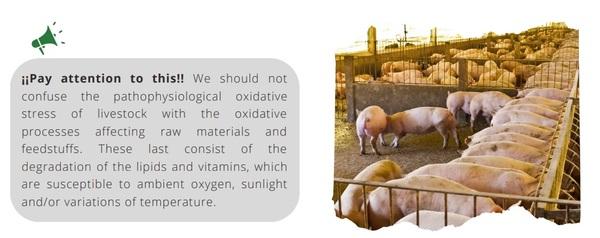
Content sponsored by:
LIPTOSA
Oxidative stress in animal production: how is it generated and how can we reduce it?
Published: March 2, 2023
By: DARÍO CLEOFÉ. Veterinarian, Export Manager
Oxidative stress is a biological process which is produced as a result of an imbalance between the generation of oxygen free radicals and the antioxidants that remove them, favorable to the first ones. In animals, free radicals are generated by endogenous pathways in aerobic metabolic processes, as well as exogenous vias, particularly after stress situations caused by inadequate environmental factors (such as temperature, relative humidity, poor air quality and/or presence of pollutants, etcetera), the action of mycotoxins, and the incidence of primary pathogens (bacteria, viruses or parasites). In addition, they must sustain an optimal and continuous productive status along the cycle to ensure the profitability of the farm.
When oxidative stress is temporarily extended, great damages occur to lipid, protein and DNA molecular structures. Finally, cells become damaged and also their function, resulting in a higher incidence of diseases (especially opportunistic pathogens), worsening of productive parameters and, consequently, several economic losses.

Naturally, during metabolic oxidation processes, biological systems prevent damage by multiple enzyme complexes (such as superoxide dismutase, catalase and glutathione peroxidase enzymes, capable of neutralizing free radicals) and other non-enzymatic biomolecules such as coenzyme Q (CoQ) or lipoic acid.
In order to reduce the impact of oxidative stress in an exogenous way, we can act nutritionally by adding antioxidant properties to feed formulas. Some examples in animal feed markets are:
- Water-soluble vitamins (vitamin C): prevent lipid oxidation and damages to DNA.
- Fat-soluble vitamins (vitamins A, D3, E, K): act by trapping free radicals and have positive actions on skin and mucous membranes, immune system, bone regeneration and hematology.
- Selenium: intervenes in the synthesis of glutathione peroxidase, which eliminates peroxide groups.
- β-carotenes and xanthophylls: are precursors of other vitamins, capable of binding free radicals and improve the immune response capacity.
- Flavonoids found in feed raw materials: activate glutathione peroxidase and catalase enzymes.
AND…HOW HAS THE CONTROL OF OXIDATIVE STRESS BEEN MANAGED ALONG TIME?
- Poultry
Addition of antioxidants such as vitamin E, Se and carotenes is considered as routine. Vitamin E promotes daily weight gain and feed conversion, prevents muscle pathologies, reduces heat stress and improves egg laying in hens.
- Swine
Supplementation with vitamin E and Se in piglets has increased the immune response against intestinal Escherichia coli infections, enhancing immunoglobulin titers in the milk of lactating sows. Dietary inclusion of β-carotene also shows stimulatory effects on white blood cells. Vitamin C has been employed in post-weaning piglets showing effects as a growth booster.
- Ruminants
Vitamin E in the diet of ruminants minimizes the incidence of diseases, and improves the productive response. It might also stimulate the immune response, with beneficial effects on the proliferation of B and T lymphocytes in both calves and adult cows. In dairy cows, supplementation with carotenoids and xanthophylls has increased their resistance to the mastitis and metritis outbreaks.
In cattle species, the addition of antioxidants in feed not only has positive effects on health, but also on the quality of carcasses since it reduces rancidity and maintains their natural coloration.
- Equine
In athletic horses, supplementation with vitamins E and C and selenium is essential, especially in the recovery stage, since muscle cells are very susceptible to irreversible injuries due to oxidative stress. In this context, antioxidants would prevent muscle fatigue and myopathies in short, medium and long-term.
*Certain information associated with products, their composition and claims may be different depending on the geographical region and may not be applicable in all countries. Liptosa reserves the right to adapt to the requirements and legislation in each case.
The information and technical recommendations provided herein are based on Liptosa's current knowledge and experience.
Liptosa reserves the right to update the information and arguments contained in this platform, as well as to make any changes to this information or recommendation at any time, without prior or subsequent notice.
Related topics:
Authors:

Influencers who recommended :
Carlos López ToméRecommend
Comment
Share
Recommend
Reply

Would you like to discuss another topic? Create a new post to engage with experts in the community.






